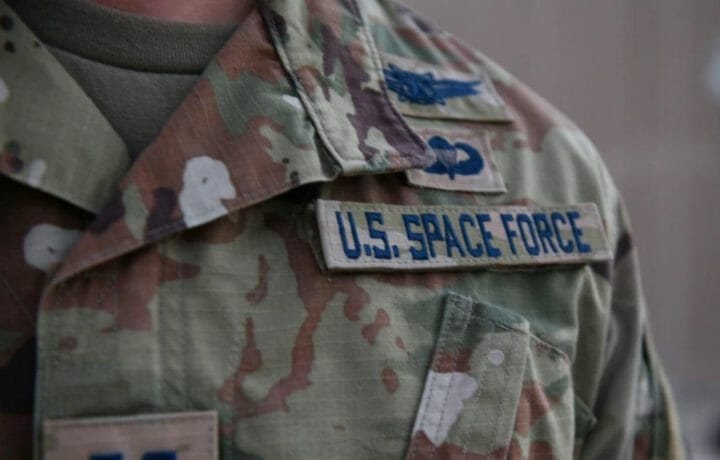In March, the United States Space Force opened its doors to prospects from the Army, Navy, and Marine Corps to transfer to the sixth and newest branch of the United States military. A total of just 50 slots were available initially yet more than 3,700 soldiers, sailors and marines applied. On Wednesday the selected troops were notified.
“We are overwhelmed by the number of applicants, and the outpouring of support our sister services have provided as we’ve partnered together to design the Space Force,” said Gen. David Thompson, vice chief of space operations,
The transfers reportedly included a mix of satellite operators, intelligence, acquisition, and cyber specialists. Forty are coming from the Army, seven from the Navy and three from the Marine Corps. About one-third of those selected are women.
Those who didn’t make the selection will still have another chance as this first transfer was largely seen as a “beta test” of the process. And this month, an additional 350 members for the sister branches will also be selected to transfer to the Space Force in the coming months. The additional transfers will fill additional positions in the aforementioned fields, as well as in engineering and acquisition.
“The competition for selection has been tough. So many of the applicants are top performers with experiences and skillsets well suited for the Space Force,” said Patricia Mulcahy, Space Force chief human capital officer. “With help from our sister services, we had the tough job of reviewing the applications to select the 50 candidates for this first transfer opportunity, and will use a similar process for the remainder.”
To the Moon and Beyond
Despite its name, those actually serving in the newest branch of the military won’t be heading to space anytime soon. Yet, the service is already considering how it could eventually be charged with taking a lead in the domain of space. As the Air Force Research Laboratory’s Space Vehicles Directorate – titled “A Primer on Cislunar Space” – recently noted, the Space Force could soon take the lead on operations around the moon and even beyond.
It isn’t likely that the lunar surface could become militarized however, at least not to the extent of what was seen in the Apple+ TV series For All Mankind. The fictional drama features an “alternate history” storyline where the Soviets landed on the moon before the United States, resulting in a Cold War in space with an armed build-up.
While the series is of course fiction, this week Chief of Space Operations Gen. John W. “Jay” Raymond warned that America’s adversaries have already begun to operate as if space was in fact a war fighting domain, and this has included the development of space-based weapon capabilities that could target vulnerable American satellites.
Raymond claimed that Russia and China are fielding the systems that can blind, disrupt, or damage our satellites, anti-satellite weapons in space, while also targeting cyber capabilities to deny America’s access to the domain.
House Armed Services Committee chairman Adam Smith also told Air Force Magazine this week that satellite survivability and redundancy were his top priorities for fending off adversaries and that a closer look at the budget for the Space Force was necessary.
“I don’t think ‘catch-up,’ is the right word,” Smith said. “We’re not behind in this area.”
However, there is the danger that Moscow and Beijing could “team up” and use space as a war fighting domain – despite the fact that the two nations had submitted a UN resolution in 2008 to limit the development space weapons.
In the years since, the cooperation between Russia and China has increased and that includes Russian efforts to help with the first Chinese space station as well as discussions for a planned lunar base. The two nations unveiled a roadmap for a joint International Lunar Research Station at the Global Space Exploration (GLEX) conference in St. Petersburg, Russia last month.
Directed Energy Systems
The U.S. Space Force won’t likely be caught off guard like NASA was in the fictional TV series however, and already the service has acknowledged that it is developing “appropriate” directed-energy systems as a way to maintain American space superiority.
Last month, Gen. Raymond told lawmakers, including Rep. Jim Langevin (D-R.I.), when asked if the U.S. was developing the weapons and means to protect U.S. satellites and other space assets, “yes sir, we are. We have to be able to protect these capabilities that we rely so heavily on.”
The Missile Defense Agency has previously explored ways to utilize space-based lasers to intercept ballistic missiles, while other nations have also attempted to deploy ground-based laser dazzling weapons that could target an adversary’s satellites.
“General Raymond has stated many times that China and Russia have directed energy capabilities that are designed to damage or destroy our satellites,” the Space Force said in a statement following up on Raymond’s comments. “His response to Congressman James Langevin’s question was confirming that our architecture developments in the face of these threats are appropriate.”




